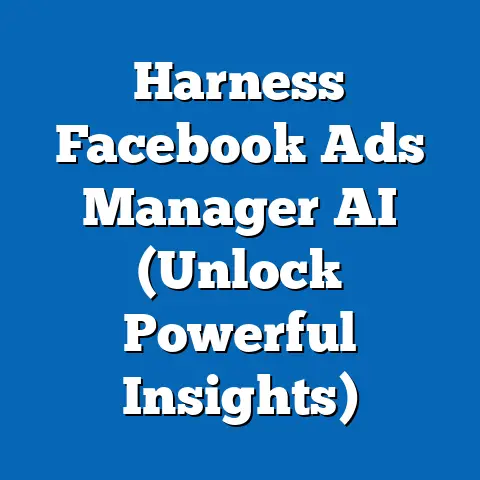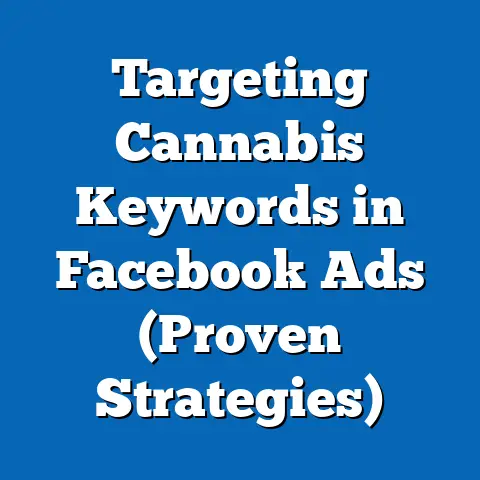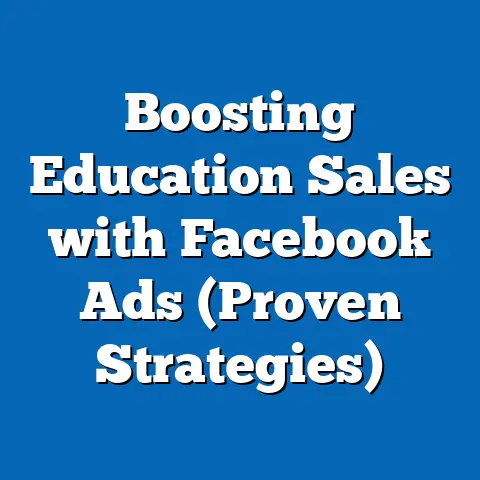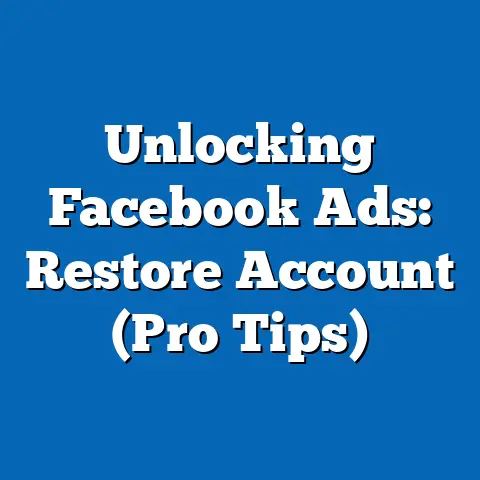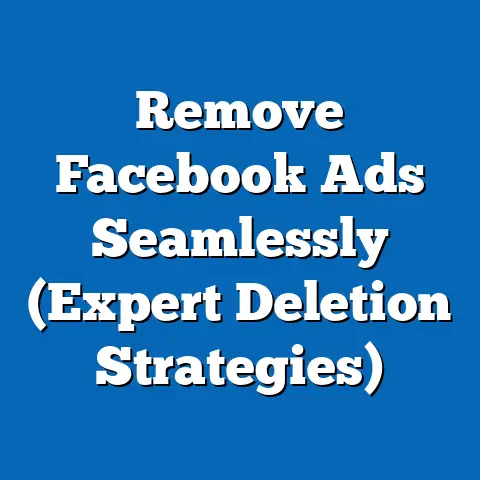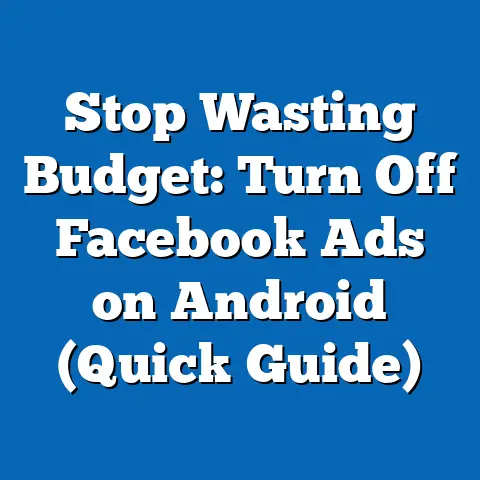Boost Facebook Ad Clicks (Proven Strategies Revealed)
In the ever-evolving landscape of digital marketing, the difference between a successful Facebook ad campaign and a complete flop often comes down to one critical factor: click-through rates. I’ve seen it firsthand, both in my own campaigns and in those of my clients – a seemingly small increase in CTR can lead to a massive boost in conversions and revenue. Facebook advertising, when done right, is a powerful tool for reaching your target audience, building brand awareness, and driving sales. But with so much noise on the platform, how do you ensure your ads are the ones that grab attention and, more importantly, get clicked?
Understanding Facebook Ad Metrics
Before we dive into the strategies, it’s crucial to understand the language of Facebook advertising. Think of it like learning the rules of the game before you start playing. The foundation of any successful campaign lies in understanding the key metrics that influence its performance. And when we talk about boosting ad clicks, our primary focus is, of course, the Click-Through Rate (CTR).
What is Click-Through Rate (CTR)?
CTR is the percentage of people who see your ad (impressions) and then actually click on it. It’s calculated by dividing the number of clicks your ad receives by the number of times it’s shown (impressions), then multiplying by 100 to get a percentage.
Formula: CTR = (Clicks / Impressions) x 100
For example, if your ad is shown 1,000 times (1,000 impressions) and receives 30 clicks, your CTR would be 3%.
Why is CTR Important?
CTR is a vital indicator of your ad’s effectiveness. Here’s why:
- Relevance: A high CTR suggests your ad is relevant to the audience you’re targeting. People are clicking because they’re interested in what you’re offering.
- Ad Quality: Facebook’s algorithm uses CTR as one of the factors to determine your ad’s quality score. A higher quality score can lead to lower ad costs and better ad placement.
- Cost Efficiency: A good CTR means you’re getting more clicks for your budget. This translates to a lower Cost Per Click (CPC) and a higher return on investment.
- Increased Conversions: Ultimately, the goal of most Facebook ad campaigns is to drive conversions – whether that’s sales, leads, or sign-ups. A higher CTR means more people are landing on your website or landing page, increasing the potential for conversions.
Beyond CTR: Other Important Metrics
While CTR is our primary focus, it’s important to understand how it relates to other key metrics:
- Cost Per Click (CPC): This is the average amount you pay each time someone clicks on your ad. A lower CPC is generally desirable, as it means you’re getting more clicks for your budget.
- Conversion Rate: This is the percentage of people who click on your ad and then complete a desired action, such as making a purchase or filling out a form.
- Return on Ad Spend (ROAS): This metric measures the revenue you generate for every dollar you spend on advertising. It’s a critical indicator of your campaign’s profitability.
- Impressions: The number of times your ad is shown.
- Reach: The number of unique people who saw your ad.
- Frequency: The average number of times each person saw your ad.
How They Relate:
These metrics are all interconnected. For example, a high CTR can lead to a lower CPC, which can then improve your ROAS. Similarly, if your CTR is high but your conversion rate is low, it suggests there’s a disconnect between your ad and your landing page.
My Personal Experience:
I remember one campaign I ran for a local bakery. Initially, the CTR was low, around 0.5%. After analyzing the data, I realized the ad copy wasn’t resonating with the target audience. I A/B tested different copy variations, focusing on highlighting the freshness and quality of the bakery’s ingredients. The result? The CTR jumped to 2.5%, and the conversion rate doubled. This experience taught me the importance of constantly monitoring and optimizing your ad campaigns based on data.
Takeaway:
Understanding Facebook ad metrics is the first step towards boosting your ad clicks. CTR is a key indicator of your ad’s relevance and quality, and it’s closely linked to other important metrics like CPC, conversion rate, and ROAS. By tracking these metrics and analyzing the data, you can identify areas for improvement and tailor your strategies for better results.
Next Step: Start tracking your Facebook ad metrics regularly. Use Facebook Ads Manager to monitor your CTR, CPC, conversion rate, and ROAS. Pay attention to trends and identify areas where you can improve.
Targeting the Right Audience
You can have the most beautifully designed ad with the wittiest copy, but if it’s shown to the wrong people, it’s destined to fail. Think of it like trying to sell snow shovels in Miami – the product might be great, but the audience simply isn’t there. That’s why audience targeting is absolutely crucial for maximizing your Facebook ad clicks.
The Power of Precision
Facebook offers a wealth of targeting options, allowing you to reach incredibly specific segments of users. This precision is what sets Facebook advertising apart from traditional advertising channels. Instead of broadcasting your message to a mass audience, you can focus on reaching the people who are most likely to be interested in your product or service.
Facebook’s Targeting Options: A Deep Dive
Here’s a breakdown of the main targeting options available on Facebook:
- Demographic Targeting: This allows you to target users based on their age, gender, location, education, job title, relationship status, and more.
- Interest-Based Targeting: This allows you to target users based on their interests, hobbies, and pages they’ve liked on Facebook.
- Behavior-Based Targeting: This allows you to target users based on their online behavior, such as their purchase history, device usage, and travel habits.
- Custom Audiences: This allows you to target users based on your own data, such as email lists, website visitors, or app users.
- Lookalike Audiences: This allows you to create audiences that are similar to your existing customers or website visitors.
Creating Custom Audiences: Unleash Your Data
Custom Audiences are one of the most powerful targeting tools available on Facebook. They allow you to leverage your existing customer data to reach highly qualified prospects.
Here are a few ways you can use Custom Audiences:
- Email List: Upload your email list to Facebook and target users who are already subscribed to your newsletter or have purchased from you in the past.
- Website Visitors: Install the Facebook Pixel on your website and track visitors to specific pages. You can then retarget these visitors with relevant ads.
- App Users: If you have a mobile app, you can target users who have downloaded or interacted with your app.
Lookalike Audiences: Expanding Your Reach
Lookalike Audiences allow you to expand your reach beyond your existing customer base. Facebook analyzes your Custom Audiences and identifies users who share similar characteristics, interests, and behaviors.
Here’s how you can use Lookalike Audiences:
- Seed Audience: Choose a Custom Audience to use as your “seed” audience. This could be your email list, website visitors, or app users.
- Audience Size: Select the size of your Lookalike Audience. A smaller audience will be more closely matched to your seed audience, while a larger audience will have broader reach.
- Location: Choose the location of your Lookalike Audience.
Refining Your Targeting: Best Practices
Here are some tips for refining your audience targeting to ensure your ads reach the most relevant users:
- Start with a broad audience and narrow it down: Don’t try to target everyone at once. Start with a broad audience based on demographics and interests, and then gradually narrow it down based on performance data.
- Use layered targeting: Combine multiple targeting options to create a more specific audience. For example, you could target women aged 25-35 who are interested in yoga and live in New York City.
- Exclude irrelevant audiences: Exclude audiences that are not likely to be interested in your product or service. For example, if you’re selling luxury cars, you might want to exclude users with low incomes.
- Test different audiences: Don’t be afraid to experiment with different targeting options. A/B test different audiences to see which ones perform best.
- Monitor your audience performance: Regularly monitor your audience performance in Facebook Ads Manager. Pay attention to which audiences are generating the most clicks, conversions, and revenue.
My Personal Experience:
I once worked with an e-commerce client that sold handmade jewelry. Initially, they were targeting a broad audience of women aged 18-55 who were interested in fashion. The results were underwhelming. After analyzing the data, I realized that the majority of their sales were coming from women aged 25-45 who were interested in ethical and sustainable fashion. I refined the targeting accordingly, and the CTR increased by 50%. This experience highlighted the importance of using data to inform your targeting decisions.
Takeaway:
Targeting the right audience is essential for boosting your Facebook ad clicks. By leveraging Facebook’s powerful targeting options, you can reach the people who are most likely to be interested in your product or service. Don’t be afraid to experiment with different targeting options and use data to inform your decisions.
Next Step: Review your current Facebook ad campaigns and evaluate your audience targeting. Are you reaching the right people? Are you using Custom Audiences and Lookalike Audiences effectively? Make adjustments as needed to ensure your ads are reaching the most relevant users.
Crafting Compelling Ad Copy
You’ve targeted the right audience, great! Now, how do you make them want to click? This is where the art of compelling ad copy comes in. Your ad copy is your chance to grab attention, communicate your value proposition, and persuade users to take action. It’s the voice of your brand, and it needs to be clear, concise, and persuasive.
The Power of Words
In the digital age, where attention spans are shorter than ever, the words you use in your ad copy can make or break your campaign. Think of your ad copy as a mini-sales pitch. You have a limited amount of space and time to convince users that your product or service is worth their attention and their click.
Key Elements of Compelling Ad Copy
Here are some key elements to consider when crafting your Facebook ad copy:
- Clarity: Your ad copy should be easy to understand and free of jargon. Communicate your message clearly and concisely.
- Value Proposition: Highlight the benefits of your product or service. What problem does it solve? What value does it provide?
- Urgency: Create a sense of urgency to encourage users to take action now. Use words like “limited time offer,” “sale ends soon,” or “don’t miss out.”
- Emotional Appeal: Connect with your audience on an emotional level. Use language that evokes feelings of excitement, happiness, or relief.
- Call to Action (CTA): Tell users exactly what you want them to do. Use clear and concise CTAs like “Shop Now,” “Learn More,” “Sign Up,” or “Get Started.”
Examples of High-Performing Ad Copy
Let’s take a look at some examples of high-performing ad copy and analyze what makes them effective:
Example 1: E-commerce Ad for a Clothing Brand
- Headline: “Summer Sale: Up to 50% Off!”
- Body: “Get ready for summer with our latest collection of stylish and affordable clothing. Limited time offer: Up to 50% off all summer styles. Shop now and upgrade your wardrobe!”
- CTA: “Shop Now”
Analysis:
- Clarity: The ad copy is clear and easy to understand.
- Value Proposition: The ad highlights the benefits of affordable and stylish clothing.
- Urgency: The ad creates a sense of urgency with the “limited time offer” and “sale ends soon” phrases.
- CTA: The CTA is clear and concise.
Example 2: Lead Generation Ad for a Software Company
- Headline: “Free Trial: Try Our Software for 30 Days”
- Body: “Streamline your workflow and boost your productivity with our powerful software. Get a free 30-day trial and experience the benefits for yourself. No credit card required.”
- CTA: “Start Free Trial”
Analysis:
- Clarity: The ad copy is clear and easy to understand.
- Value Proposition: The ad highlights the benefits of streamlining workflow and boosting productivity.
- Call to Action: The CTA is clear and concise.
- Risk Reversal: The ad reduces risk by offering a free trial with no credit card required.
Tips for A/B Testing Ad Copy
A/B testing is a crucial part of optimizing your ad copy. It allows you to test different variations of your ad copy and see which ones perform best.
Here are some tips for A/B testing your ad copy:
- Test one element at a time: To get accurate results, test only one element of your ad copy at a time. For example, test different headlines, body copy, or CTAs.
- Use a control group: Create a control group that sees your original ad copy. This will allow you to compare the performance of your test variations against a baseline.
- Run your tests for a sufficient amount of time: Run your tests for at least a week to gather enough data to make statistically significant conclusions.
- Analyze your results: Use Facebook Ads Manager to analyze your results and identify the ad copy variations that performed best.
- Implement your findings: Implement the winning ad copy variations in your live campaigns.
My Personal Experience:
I once ran an A/B test for a client that sold online courses. We tested two different headlines:
- Headline A: “Learn New Skills Online”
- Headline B: “Unlock Your Potential with Online Courses”
Headline B significantly outperformed Headline A, resulting in a 30% increase in CTR. This experience taught me the importance of testing different ad copy variations to see what resonates best with your target audience.
Takeaway:
Crafting compelling ad copy is essential for boosting your Facebook ad clicks. Use clear, concise language that highlights the benefits of your product or service. Create a sense of urgency and connect with your audience on an emotional level. Don’t forget to include a clear and concise call to action. And most importantly, A/B test different ad copy variations to see what performs best.
Next Step: Review your current Facebook ad campaigns and evaluate your ad copy. Is it clear, concise, and persuasive? Does it highlight the benefits of your product or service? Does it include a clear call to action? A/B test different ad copy variations to see what resonates best with your target audience.
Designing Eye-Catching Visuals
Think about scrolling through your own Facebook feed. What makes you stop? More often than not, it’s a striking image or a captivating video. In the fast-paced world of social media, visuals are your first opportunity to grab attention and make a lasting impression. They’re the silent salesperson, working tirelessly to draw users in and entice them to click.
The Power of Visuals
Visuals are processed 60,000 times faster in the brain than text. This means that your ad’s visual is the first thing users will notice, and it can significantly impact their decision to click. A well-designed visual can communicate your message more effectively than words alone.
Best Practices for Creating Eye-Catching Visuals
Here are some best practices for creating eye-catching images and videos that stand out in users’ feeds:
- Use high-quality images and videos: Avoid using blurry, pixelated, or low-resolution visuals. Invest in professional photography or videography, or use high-quality stock photos and videos.
- Use bright and vibrant colors: Use colors that are eye-catching and visually appealing. Consider using your brand colors to maintain consistency.
- Use images and videos that are relevant to your ad copy: Make sure your visuals are relevant to your ad copy and your product or service.
- Use images and videos that tell a story: Use visuals that evoke emotions and tell a story.
- Use images and videos that are optimized for mobile: Most Facebook users access the platform on their mobile devices. Make sure your visuals are optimized for mobile viewing.
- Use visuals that are consistent with your brand: Maintain consistency in your visual design to reinforce your brand identity.
- Test different visuals: A/B test different visuals to see which ones perform best.
The Importance of Branding and Consistency
Your visuals should be consistent with your brand’s overall look and feel. This will help you reinforce your brand identity and build brand recognition. Use your brand colors, fonts, and imagery in your visuals.
Tools and Resources for Creating Professional-Looking Ad Visuals
Here are some tools and resources for creating professional-looking ad visuals:
- Canva: A user-friendly graphic design tool that allows you to create stunning visuals without any design experience.
- Adobe Creative Cloud: A suite of professional graphic design tools, including Photoshop, Illustrator, and Premiere Pro.
- Unsplash: A website that offers free, high-quality stock photos.
- Pexels: Another website that offers free, high-quality stock photos and videos.
- Animoto: A video creation tool that allows you to create professional-looking videos quickly and easily.
Case Studies of Successful Ad Campaigns with Strong Visuals
Let’s take a look at some case studies of successful ad campaigns that utilized strong visuals:
Case Study 1: Airbnb
Airbnb is known for its stunning visuals that showcase unique and inspiring travel destinations. Their Facebook ads often feature high-quality photos and videos of their properties, highlighting the unique experiences that travelers can have.
Key Takeaway: Use visuals that showcase the unique features and benefits of your product or service.
Case Study 2: Dollar Shave Club
Dollar Shave Club is known for its humorous and engaging videos that promote their shaving products. Their videos are often quirky and unexpected, and they resonate with their target audience.
Key Takeaway: Use visuals that are engaging and entertaining to capture attention.
Case Study 3: Warby Parker
Warby Parker is known for its stylish and modern eyewear. Their Facebook ads often feature high-quality photos of their glasses, showcasing the different styles and colors available.
Key Takeaway: Use visuals that showcase the style and quality of your product.
My Personal Experience:
I once worked with a client that sold handmade soaps. Initially, their Facebook ads featured generic stock photos of soap. The results were underwhelming. I suggested that they invest in professional photography that showcased the natural ingredients and vibrant colors of their soaps. The results were dramatic. The CTR increased by 100%, and the conversion rate doubled. This experience taught me the importance of investing in high-quality visuals that showcase the unique features and benefits of your product.
Takeaway:
Designing eye-catching visuals is crucial for boosting your Facebook ad clicks. Use high-quality images and videos that are relevant to your ad copy. Maintain consistency in your visual design to reinforce your brand identity. Don’t be afraid to experiment with different visuals and A/B test them to see which ones perform best.
Next Step: Review your current Facebook ad campaigns and evaluate your visuals. Are they high-quality and visually appealing? Are they relevant to your ad copy? Are they consistent with your brand? A/B test different visuals to see which ones perform best.
Utilizing Facebook Ad Formats Effectively
Facebook offers a variety of ad formats, each with its own strengths and weaknesses. Choosing the right ad format is crucial for maximizing engagement and click-through rates. It’s like choosing the right tool for the job – a hammer won’t work if you need a screwdriver. Understanding the nuances of each format will allow you to tailor your campaigns for optimal performance.
Understanding Your Options
Here’s a breakdown of the most common Facebook ad formats:
- Image Ads: These are the simplest and most common ad format, consisting of a single image, headline, body text, and call to action.
- Video Ads: These ads feature a video that can be up to 240 minutes long. They are highly engaging and can be used to tell stories, demonstrate products, or provide tutorials.
- Carousel Ads: These ads allow you to showcase multiple images or videos in a single ad unit. Users can swipe through the carousel to see different products or features.
- Collection Ads: These ads are designed for e-commerce businesses and allow you to showcase a collection of products in a visually appealing format.
- Instant Experience Ads: These ads open in a full-screen mobile experience when clicked. They can be used to showcase products, tell stories, or provide interactive experiences.
- Lead Ads: These ads allow you to collect leads directly within Facebook. Users can fill out a form without leaving the platform.
- Messenger Ads: These ads appear in the Facebook Messenger app and can be used to start conversations with potential customers.
Advantages and Disadvantages of Each Format
Let’s take a closer look at the advantages and disadvantages of each ad format:
| Ad Format | Advantages | Disadvantages |
|---|---|---|
| Image Ads | Simple to create, cost-effective, good for driving traffic to your website. | Can be less engaging than other formats, may not be suitable for complex products or services. |
| Video Ads | Highly engaging, can be used to tell stories, demonstrate products, or provide tutorials. | Can be more expensive to produce, requires a strong video strategy. |
| Carousel Ads | Allows you to showcase multiple products or features, good for e-commerce businesses. | Can be more complex to set up, requires high-quality images or videos. |
| Collection Ads | Designed for e-commerce businesses, allows you to showcase a collection of products in a visually appealing format. | Can be more expensive to set up, requires a strong product catalog. |
| Instant Experience Ads | Creates a full-screen mobile experience, good for showcasing products, telling stories, or providing interactive experiences. | Can be more complex to set up, requires a strong understanding of mobile design. |
| Lead Ads | Allows you to collect leads directly within Facebook, good for generating leads for your business. | Requires a strong lead nurturing strategy, may not be suitable for all businesses. |
| Messenger Ads | Allows you to start conversations with potential customers, good for providing customer support or generating leads. | Requires a dedicated team to manage conversations, may not be suitable for all businesses. |
| Ad Format | Advantages | Disadvantages |
|---|---|---|
| Image Ads | Simple to create, cost-effective, good for driving traffic to your website. | Can be less engaging than other formats, may not be suitable for complex products or services. |
| Video Ads | Highly engaging, can be used to tell stories, demonstrate products, or provide tutorials. | Can be more expensive to produce, requires a strong video strategy. |
| Carousel Ads | Allows you to showcase multiple products or features, good for e-commerce businesses. | Can be more complex to set up, requires high-quality images or videos. |
| Collection Ads | Designed for e-commerce businesses, allows you to showcase a collection of products in a visually appealing format. | Can be more expensive to set up, requires a strong product catalog. |
| Instant Experience Ads | Creates a full-screen mobile experience, good for showcasing products, telling stories, or providing interactive experiences. | Can be more complex to set up, requires a strong understanding of mobile design. |
| Lead Ads | Allows you to collect leads directly within Facebook, good for generating leads for your business. | Requires a strong lead nurturing strategy, may not be suitable for all businesses. |
| Messenger Ads | Allows you to start conversations with potential customers, good for providing customer support or generating leads. | Requires a dedicated team to manage conversations, may not be suitable for all businesses. |
Case Studies of Successful Campaigns Using Various Ad Formats
Let’s take a look at some case studies of successful campaigns that have effectively used various ad formats:
Case Study 1: Nike (Video Ads)
Nike is known for its inspiring and motivational video ads that feature athletes pushing their limits. Their video ads are highly engaging and resonate with their target audience.
Key Takeaway: Use video ads to tell stories and connect with your audience on an emotional level.
Case Study 2: Sephora (Carousel Ads)
Sephora uses carousel ads to showcase a variety of makeup products. Users can swipe through the carousel to see different products and learn more about each one.
Key Takeaway: Use carousel ads to showcase multiple products or features.
Case Study 3: Shopify (Lead Ads)
Shopify uses lead ads to generate leads for their e-commerce platform. Users can fill out a form directly within Facebook to request a free trial.
Key Takeaway: Use lead ads to collect leads directly within Facebook.
Strategies for Selecting the Right Ad Format
Here are some strategies for selecting the right ad format based on your campaign goals and audience preferences:
- Consider your campaign goals: What are you trying to achieve with your ad campaign? Are you trying to drive traffic to your website, generate leads, or increase sales?
- Consider your target audience: What are the interests and preferences of your target audience? What type of content do they engage with on Facebook?
- Consider your budget: Some ad formats are more expensive to create and run than others.
- Experiment with different formats: Don’t be afraid to experiment with different ad formats to see which ones perform best.
My Personal Experience:
I once worked with a client that sold online courses. Initially, they were only using image ads. The results were mediocre. I suggested that they try using video ads to showcase the benefits of their courses. The results were dramatic. The CTR increased by 200%, and the conversion rate tripled. This experience taught me the importance of experimenting with different ad formats to see what resonates best with your target audience.
Takeaway:
Utilizing Facebook ad formats effectively is crucial for boosting your ad clicks. Understand the advantages and disadvantages of each format and choose the right format based on your campaign goals and audience preferences. Don’t be afraid to experiment with different formats and A/B test them to see which ones perform best.
Next Step: Review your current Facebook ad campaigns and evaluate your ad formats. Are you using the right formats for your campaign goals and audience preferences? A/B test different ad formats to see which ones perform best.
Implementing Retargeting Strategies
Imagine someone walks into your store, browses around, but leaves without buying anything. Would you just let them go? Of course not! You might offer them a discount, show them other products, or simply ask if they need help. Retargeting is the online equivalent of this, and it’s incredibly powerful for boosting ad clicks and conversions.
What is Retargeting?
Retargeting is a marketing technique that allows you to show ads to people who have previously interacted with your website, app, or Facebook page. It’s a way to re-engage users who have already shown interest in your brand.
How Retargeting Works on Facebook
Retargeting on Facebook works by using the Facebook Pixel, a small piece of code that you install on your website. The Pixel tracks visitors to your website and collects data about their behavior, such as the pages they visited, the products they viewed, and the actions they took.
You can then use this data to create Custom Audiences of website visitors and show them targeted ads on Facebook.
Types of Audiences You Can Retarget
Here are some types of audiences you can retarget on Facebook:
- Website Visitors: Target users who have visited your website in the past.
- Page Viewers: Target users who have visited specific pages on your website, such as product pages or landing pages.
- Product Viewers: Target users who have viewed specific products on your website.
- Add to Cart: Target users who have added products to their cart but haven’t completed the purchase.
- Purchasers: Target users who have purchased from you in the past.
- Video Viewers: Target users who have watched your videos on Facebook.
- Lead Form Engagers: Target users who have interacted with your lead forms on Facebook.
Strategies for Creating Effective Retargeting Campaigns
Here are some strategies for creating retargeting campaigns that re-engage users who have previously interacted with your brand:
- Segment your audience: Don’t show the same ad to everyone. Segment your audience based on their behavior and show them targeted ads that are relevant to their interests.
- Use dynamic product ads: If you’re an e-commerce business, use dynamic product ads to show users the products they viewed on your website.
- Offer discounts and promotions: Offer discounts and promotions to encourage users to complete a purchase.
- Use compelling ad copy and visuals: Use ad copy and visuals that are relevant to your audience and highlight the benefits of your product or service.
- Test different ad placements: Test different ad placements to see which ones perform best.
- Exclude existing customers: Exclude existing customers from your retargeting campaigns to avoid showing them ads for products they’ve already purchased.
Examples of Successful Retargeting Campaigns
Let’s take a look at some examples of successful retargeting campaigns and the results achieved:
Example 1: E-commerce Business (Abandoned Cart Retargeting)
An e-commerce business retargeted users who had added products to their cart but hadn’t completed the purchase. They showed these users dynamic product ads featuring the products they had added to their cart, along with a discount code. The result was a 20% increase in sales.
Example 2: Software Company (Free Trial Retargeting)
A software company retargeted users who had visited their website but hadn’t signed up for a free trial. They showed these users ads highlighting the benefits of their software and offering a free 30-day trial. The result was a 15% increase in free trial sign-ups.
My Personal Experience:
I once worked with a client that sold high-end furniture. They were struggling to convert website visitors into customers. I implemented a retargeting campaign that targeted users who had viewed specific products on their website. I showed these users ads featuring the products they had viewed, along with customer testimonials and a limited-time discount. The result was a 30% increase in sales. This experience taught me the power of retargeting for driving conversions.
Takeaway:
Implementing retargeting strategies is essential for boosting your ad clicks and conversions. Use the Facebook Pixel to track visitors to your website and create Custom Audiences. Segment your audience based on their behavior and show them targeted ads that are relevant to their interests. Offer discounts and promotions to encourage users to complete a purchase.
Next Step: Install the Facebook Pixel on your website and start creating Custom Audiences of website visitors. Segment your audience based on their behavior and create targeted retargeting campaigns that are relevant to their interests.
Leveraging Facebook Insights for Continuous Improvement
You’ve implemented all the strategies we’ve discussed so far, but your work isn’t done yet! Facebook advertising is an ongoing process of testing, learning, and optimizing. That’s where Facebook Insights comes in. Think of it as your campaign’s report card – it tells you what’s working, what’s not, and where you can improve.
The Importance of Data Analysis
Data analysis is crucial for optimizing your Facebook ad campaigns. By tracking performance and gathering actionable data, you can identify trends, understand your audience, and make informed decisions about your ad strategies.
Using Facebook Insights and Ads Manager
Facebook Insights and Ads Manager are powerful tools that provide a wealth of data about your ad campaigns. Here are some key metrics you can track:
- Reach: The number of unique people who saw your ad.
- Impressions: The number of times your ad was shown.
- Frequency: The average number of times each person saw your ad.
- Clicks: The number of times people clicked on your ad.
- Click-Through Rate (CTR): The percentage of people who saw your ad and clicked on it.
- Cost Per Click (CPC): The average amount you paid for each click.
- Conversions: The number of people who completed a desired action after clicking on your ad, such as making a purchase or filling out a form.
- Conversion Rate: The percentage of people who clicked on your ad and completed a desired action.
- Return on Ad Spend (ROAS): The revenue you generated for every dollar you spent on advertising.
Interpreting Data to Identify Trends and Areas for Improvement
Here are some strategies for interpreting data to identify trends and areas for improvement:
- Track your key metrics over time: Monitor your key metrics over time to identify trends and patterns. Are your clicks increasing or decreasing? Is your CPC going up or down?
- Compare different ad campaigns: Compare the performance of different ad campaigns to see which ones are performing best. What are the key differences between the successful campaigns and the unsuccessful campaigns?
- Segment your data: Segment your data by audience, ad placement, and ad creative to identify which segments are performing best.
- Look for outliers: Look for outliers in your data. Are there any segments that are performing significantly better or worse than others?
- Use A/B testing: A/B test different ad variations to see which ones perform best.
Ongoing Testing, Learning, and Adapting
The key to success with Facebook advertising is to constantly test, learn, and adapt your strategies based on the insights you gain from your data. Don’t be afraid to experiment with new ad formats, targeting options, and ad creative.
My Personal Experience:
I once worked with a client that was running a Facebook ad campaign to promote their new mobile app. Initially, the campaign was performing well, but after a few weeks, the results started to decline. I analyzed the data and discovered that the frequency was very high, meaning that people were seeing the ad too many times. I reduced the frequency and the results improved. This experience taught me the importance of monitoring your campaign data and making adjustments as needed.
Takeaway:
Leveraging Facebook Insights for continuous improvement is essential for maximizing your Facebook ad performance. Track your key metrics, analyze your data, and identify trends and areas for improvement. Don’t be afraid to experiment with new strategies and adapt your campaigns based on the insights you gain.
Next Step: Review your current Facebook ad campaigns and analyze your data in Facebook Insights and Ads Manager. Identify trends and areas for improvement. Make adjustments to your campaigns based on your findings.
Conclusion
Boosting Facebook ad clicks is not a one-time fix, but rather a continuous process of refinement and optimization. As I’ve shared, it’s a combination of understanding your metrics, targeting the right audience, crafting compelling copy, designing eye-catching visuals, leveraging the right ad formats, implementing retargeting strategies, and, most importantly, continuously analyzing your data and adapting your approach. Remember, the Facebook advertising landscape is constantly evolving, so staying informed and adaptable is key to long-term success.
I encourage you to implement these strategies in your own campaigns and take your Facebook advertising to new heights. It’s time to stop guessing and start using data-driven insights to drive real results.
Call to Action
I’m eager to hear about your experiences! After applying these strategies in your own campaigns, please share your results and insights. What worked best for you? What challenges did you face? By sharing our experiences, we can all learn from each other and become better Facebook advertisers. So, go out there, experiment, and let’s build a community of successful Facebook marketers!

